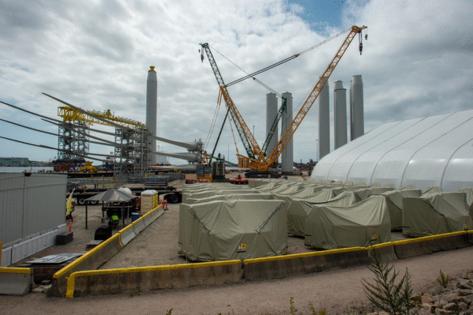'It's going to hurt us': Trump puts 15,000 offshore wind jobs at risk with halt orders
Published in News & Features
Cesar Lima never gave much thought to the politics of offshore wind. Most days, the ironworker focused on his shift 15 miles out at sea, climbing turbines and watching dolphins gliding past his vessel off the coast of Rhode Island.
That changed when President Donald Trump’s administration ordered work to stop on the Revolution Wind project a month ago.
Lima’s job is now at risk as Trump threatens to shutter offshore wind farms, upending states’ investments to support the clean energy source. The administration’s actions have postponed, if not outright eliminated, years of potential construction work. Altogether, more than 15,000 prospective and current jobs tied to wind projects in New England are under threat from the potential shutdowns, according to a Bloomberg analysis of company and state announcements.
For now, Lima and other specialized union staff are still stationed with the Revolution Wind project, and he’s continuing to get paid. But Lima worries about what comes next for his family, including three children, who depend on his income. Ironworkers on the project earn about $76 an hour with pension and health benefits, typically working 84-hour weeks on four-week rotations, according to David Langlais of the Iron Workers union.
“I just came here to work for my family and I don’t really pay attention to all the political stuff,” Lima said, adding that he was confused why the White House would stop the Revolution project when it’s already 80% completed. “If the work stops and it keeps going like this, it’s going to hurt us.”
Trump has long opposed offshore wind, suing unsuccessfully before he became president to block a project within view of his golf course in Scotland. But the recent escalation of his administration’s battle against the industry risks clashing with simultaneous claims that the White House’s policies are fueling investment and job growth.
The bulk of potential job losses stem from government actions targeting several wind farms off the New England coast. The U.S. Interior Department issued a stop-work order in August for the Revolution Wind farm, which is being built by Denmark’s Orsted A/S and Global Infrastructure Partners. The Revolution project supports more than 2,000 jobs, about half of which are union roles, according to Orsted.
The wind farm venture has sued to force the Trump administration to allow work to restart on the project. Revolution Wind has said it’s already spent $5 billion on the project and is now at risk of incurring an estimated $1 billion in breakaway costs.
“We have invested a significant amount of time and money” to support offshore wind, Rhode Island Democratic Governor Dan McKee said in an interview, referencing the state’s spending on training programs for workers, port upgrades in Quonset and a new offshore wind construction hub — all of which generated local jobs.
The Trump administration has also moved to reconsider or invalidate permits for other wind projects near Massachusetts that have yet to start construction but were expected to create more than 13,100 jobs on a combined basis. In addition, the U.S. Transportation Department yanked $34 million in funding for a new port in Salem, Massachusetts, that was meant to support the offshore wind industry. That project was slated to create an additional 800 construction jobs.
Last week, the administration asked a court to cancel the approval of a $6 billion wind project planned off Maryland’s coast. A large offshore wind project in Virginia, which has a Republican Governor, Glenn Youngkin, is continuing.
The Massachusetts Clean Energy Center has projected employment in climate-friendly power production would need to grow to more than 140,000 jobs by the end of the decade in order for the state to meet its climate goals. The state organization has already spent more than $20 million in total on offshore wind job-training programs. Last year, Massachusetts Governor Maura Healey signed a bill authorizing $200 million of investments to support offshore wind, an attempt to establish the state as a global clean energy hub in the same way it’s evolved into a life sciences mecca.
“We are talking about so many jobs, so many construction jobs, so many union jobs,” Healey said in an interview this month. “There’s been a lot of investment in this workforce, actually, to the tune of hundreds of millions of dollars. Don’t let that go to waste.”
Governors and labor leaders warn that the push to halt offshore wind development will also weigh on the manufacturing and commercial fishing industries, exacerbating the labor market impact.
“The offshore jobs are one thing, and they’re significant, but we were starting to develop the infrastructure for the industry itself,” said Frank Callahan, president of the Massachusetts Building Trades Unions.
About 80 fishermen in Rhode Island and Connecticut work for Sea Services North America, a co-op that was formed with support from Orsted to investigate potential risks to marine life from Revolution Wind’s construction. Another 100 work in similar roles across other states on the East Coast. In total, the co-op deploys 22 independent commercial fishing vessels with the work earning the participating fishermen an extra $24 million in income over four years.
“Most of our group are Trump supporters,” said Gordon Videll, CEO of Sea Services North America. “We’ve demonstrated that co-existence of commercial fisherman and offshore wind is possible. Nobody understands. It defies logic.”
Orsted also footed half the bill for a $1 million training facility in Rhode Island. The school has already trained nearly 200 students in skills such as first aid, fire awareness and special instruction for working at heights and living at sea for extended periods. The majority of course participants are union electricians and iron workers, according to Rosemary Costigan, president of the Community College of Rhode Island, which hosts the training facility on its campus.
“These are good-paying jobs, sustainable wages that the workers can have,” Costigan said. “We were on the precipice of actually expanding out and being able to recruit to a wider student audience.”
(With assistance from Jennifer A. Dlouhy and William Mathis.)
©2025 Bloomberg L.P. Visit bloomberg.com. Distributed by Tribune Content Agency, LLC.







Comments